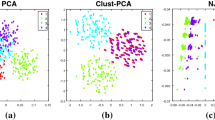Abstract
In the present work we showed that together with improved stability the Intrinsic Plasticity (IP) tuned Echo State Network (ESN) reservoirs possess also better clustering abilities that opens a possibility for application of ESNs in multidimensional data clustering. The revealed ability of ESNs is demonstrated first on an artificially created data set with known in advance number and position of clusters. Automated procedure for multidimensional data clustering was proposed. It allows discovering multidimensional data structure without specification in advance the clusters number. The developed procedure was further applied to a real data set containing concentrations of three alloying elements in numerous steel compositions. The obtained number and position of clusters showed logical from the practical point of view data separation.
Access this chapter
Tax calculation will be finalised at checkout
Purchases are for personal use only
Preview
Unable to display preview. Download preview PDF.
Similar content being viewed by others
References
Ackley, D.H., Hinton, G.E., Sejnowski, T.J.: A learning algorithm for Boltzmann machines. Cognitive Science 9, 147–169 (1985)
Brody, C.D., Romo, R., Kepecs, A.: basic mechanisms for graded persistent activity: Discrete attractors, continuous attractors, and dynamical representations. Current Opinion in Neurobiology 13, 204–211 (2003)
Jaeger, H.: Tutorial on training recurrent neural networks, covering BPPT, RTRL, EKF and the "echo state network" approach. GMD Report 159, German National Research Center for Information Technology (2002)
Haddad, W.M., Chellaboina, V.S., Nersesov, S.G.: Thermodynamics: A Dynamical System Approach. Princeton University Press (2005)
Hinton, G.E., Salakhutdinov, R.: Reducing the dimensionality of data with neural networks. Science 313(5786), 504–507 (2006)
Hopfield, J.J.: Neural networks and physical systems with emergent collective computational abilities. Proc. of National Academy of Sciences USA 79, 2554–2558 (1982)
Koprinkova-Hristova, P., Palm, G.: ESN Intrinsic Plasticity versus Reservoir Stability. In: Honkela, T. (ed.) ICANN 2011, Part I. LNCS, vol. 6791, pp. 69–76. Springer, Heidelberg (2011)
Lukosevicius, M., Jaeger, H.: Reservoir computing approaches to recurrent neural network training. Computer Science Review 3, 127–149 (2009)
Ozturk, M., Xu, D., Principe, J.: Analysis and design of Echo state networks. Neural Computation 19, 111–138 (2007)
Schrauwen, B., Wandermann, M., Verstraeten, D., Steil, J.J., Stroobandt, D.: Improving reservoirs using intrinsic plasticity. Neurocomputing 71, 1159–1171 (2008)
Steil, J.J.: Online reservoir adaptation by intrinsic plasticity for back-propagation-decoleration and echo state learning. Neural Networks 20, 353–364 (2007)
Woodward, A., Ikegami, T.: A reservoir computing approach to image classification using coupled echo state and back-propagation neural networks. In: Proc. of 26th Int. Conf. on Image and Vision Computing, Auckland, New Zealand, November 29-December 1, pp. 543–548 (2011)
Author information
Authors and Affiliations
Editor information
Editors and Affiliations
Rights and permissions
Copyright information
© 2012 Springer-Verlag Berlin Heidelberg
About this paper
Cite this paper
Koprinkova-Hristova, P., Tontchev, N. (2012). Echo State Networks for Multi-dimensional Data Clustering. In: Villa, A.E.P., Duch, W., Érdi, P., Masulli, F., Palm, G. (eds) Artificial Neural Networks and Machine Learning – ICANN 2012. ICANN 2012. Lecture Notes in Computer Science, vol 7552. Springer, Berlin, Heidelberg. https://doi.org/10.1007/978-3-642-33269-2_72
Download citation
DOI: https://doi.org/10.1007/978-3-642-33269-2_72
Publisher Name: Springer, Berlin, Heidelberg
Print ISBN: 978-3-642-33268-5
Online ISBN: 978-3-642-33269-2
eBook Packages: Computer ScienceComputer Science (R0)





